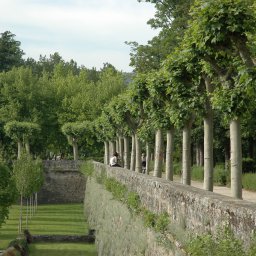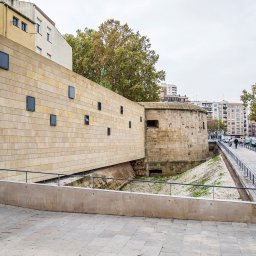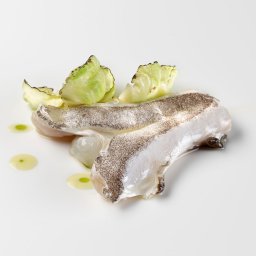Calahorra is a must-see when visiting the eastern part of La Rioja. It rests proudly on a hill where the Cidacos flows down into the River Ebro. Although the origins of the town date back to the Mousterian, it rose again during the height of the Roman Empire, lived through the medieval Kingdoms of Castile and Navarre, and has reached the present day proud of its history and fertile land.
The Roman orator and pedagogue Marco Fabio Quintiliano was born in Calahorra in the middle of the first century. Pliny the Younger, the future emperor Hadrian and possibly Tacitus studied at his school. Centuries later, the poet, literate and astronomer Abraham Ben Ma’ir Ben Ezra, a major figure in Hispanic-Jewish culture, walked the streets of the town’s Jewish Quarter.
Traces of its illustrious past can still be seen in Calahorra today. The Roman period was very prosperous and the town flourished. Calagurris, as it was known in Roman times, was sanctified by Publius Cornelius Scipio, Julius Caesar and the great Caesar Augustus, before being granted the title of municipium civium Romanorum, which bestowed full Roman citizenship on the inhabitants.
The circus where the Roman chariot races were held was located on today’s Paseo del Mercadal. Like all the important Roman cities, Calagurris enjoyed a full range of urban facilities such as temples, forums, thermal baths, a sewage system, theatres and an amphitheatre.
Legend – and some experts – have it that the Apostle James preached the new doctrine in Calahorra and that Saint Paul founded the church there. Shortly after the year 1000, the town became part of the Kingdom of Nájera-Pamplona, a forerunner to the Kingdom of Navarre. Later, Alfonso VI annexed it to the Kingdom of Castile, granted it a city charter, consolidated it as the episcopal see, and expanded the diocese by annexing the conquered Basque lands to the Kingdom of Navarre.
When the Catholic Monarchs issued the Alhambra Decree, which ordered the expulsion of the Jews from the kingdoms of Spain, many took with them surnames such as Calahorra, Alcalahorrí and Calahorrano when they left for Poland. The old synagogue was located on the site of the Convent of San Francisco, currently home to the town’s Easter Procession Museum. The Torah is stored in the Diocesan Museum, next to the Cathedral of Santa Maria.
The town’s recent history is fairly well-known but far less exciting and colourful.

Market gardens
The Cidacos and Ebro Rivers irrigate the flat land surrounding the hill. The fruit, vegetables, and livestock that grow on the land form the basis of the excellent local cuisine. The orchards and market gardens of Calahorra produce top quality produce. The traditional spring vegetables include beans, peas, artichokes and asparagus which are often used to make the traditional lamb menestra or stew. The summer harvest brings tomatoes and lettuce while autumn is the season for peppers, traditionally roasted on the streets of Calahorra in wood or charcoal-burning stoves. The winter vegetables par excellence are thistle, artichoke, cauliflower, chard and borage.
Calahorra cauliflower is identified with a Protected Geographical Indication. The local produce can be bought directly from the farmers every Thursday at the El Raso medieval market. Calahorra even has a Vegetable Interpretation Centre (located on the site of an old convent) where visitors can learn about the orchards and market gardens that cover the banks of the Ebro and their influence on the people and history of the area.
Other typical Calahorra products include lamb-based dishes, sweet pine-nut black puddings and offal. Local sweet treats include several types of sponge tea-cakes (magdalenas. mantecados, mantecosas) and the traditional almond-based ‘pastel calagurris’.
If you come in spring, bear in mind that Holy Week in Calahorra is listed as an event of National Tourist Interest. Winter visitors should note that the town celebrates the feasts of San Emeterio and San Celedonio from March 1 to 3. Have fun and mingle with the locals, but go easy on the zurracapote.

What to see on a stroll through Calahorra
El Salvador is a 12th-century cathedral in the Romanesque style, with modifications added between the 15th and 18th centuries. The treasures inside the cathedral include the Chapel of San Pedro with its alabaster altar in the Plateresque style; the Chapel of Cristo de la Pelota, with its Gothic image of the patron saint of the handball players; the Chapel of the Santos Mártires which features a Baroque altarpiece, a baptismal font in the style of the Catholic Monarchs; choir stalls in the Renaissance style; a magnificent sacristy; a priceless painting of Santa Margarita de Alejandría; several altarpieces; a cloister and the tower.Also worth visiting are the Church of San Andrés, the 17th-century Church of San Francisco, the 16th-century Church of Santiago, the 17th-century Church of the Barefoot Carmelites and 16th-century Church of the Barefoot Order of San José. Also noteworthy is the Bishop’s Palace, formed by a group of buildings built between the sixteenth and eighteenth centuries, where gold and silver objects, as well as clothing, sculptures and paintings can be seen.
Ask a local how to get to ‘La Clínica’, a first-century Roman site. And make sure to ask about the ruins of the old circus.

















